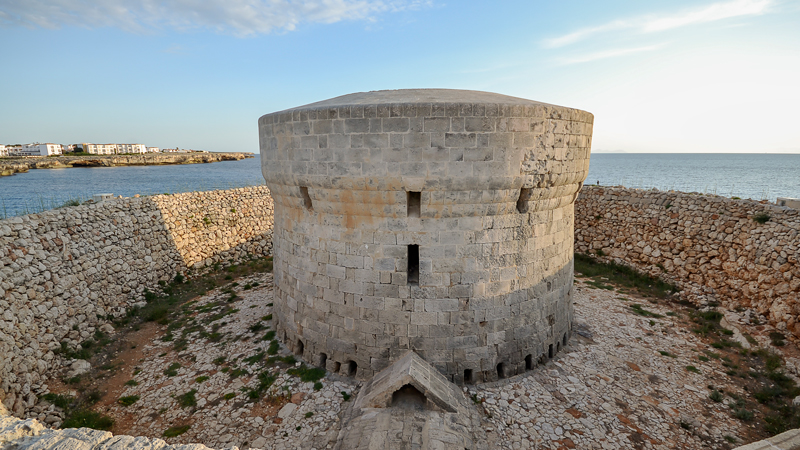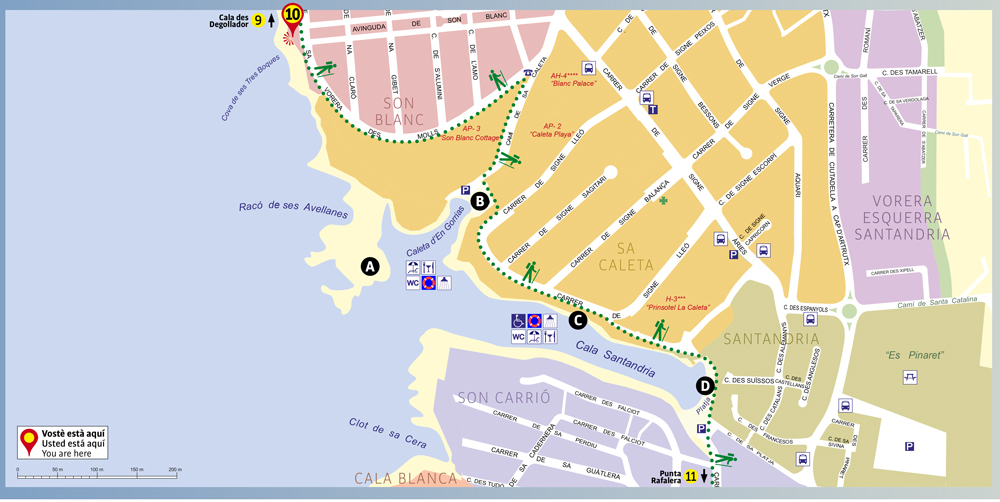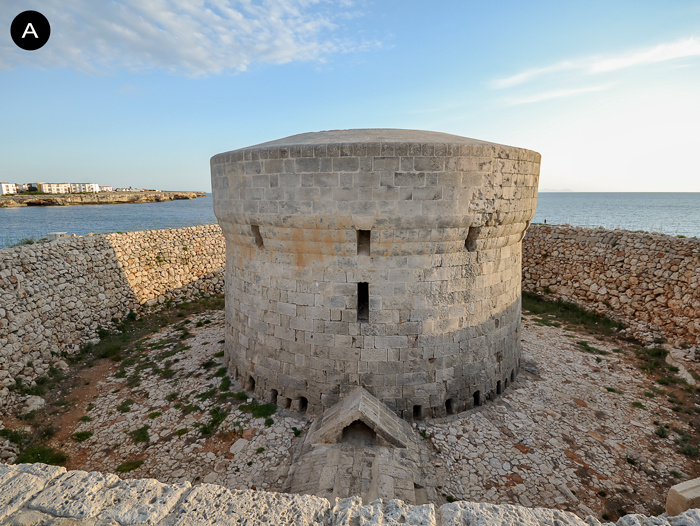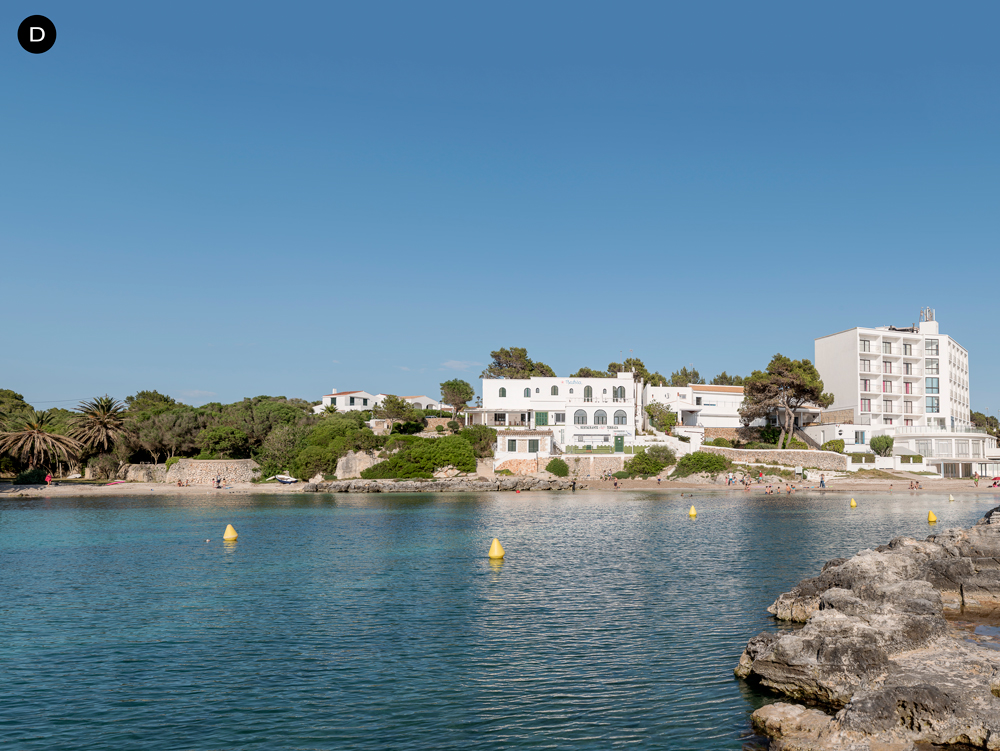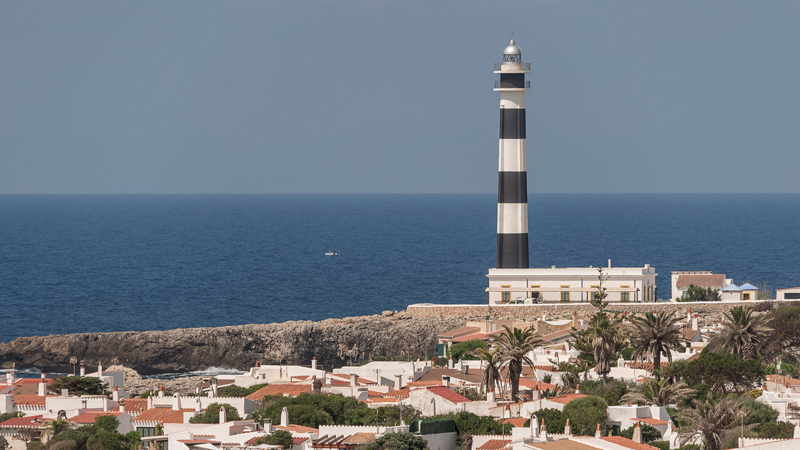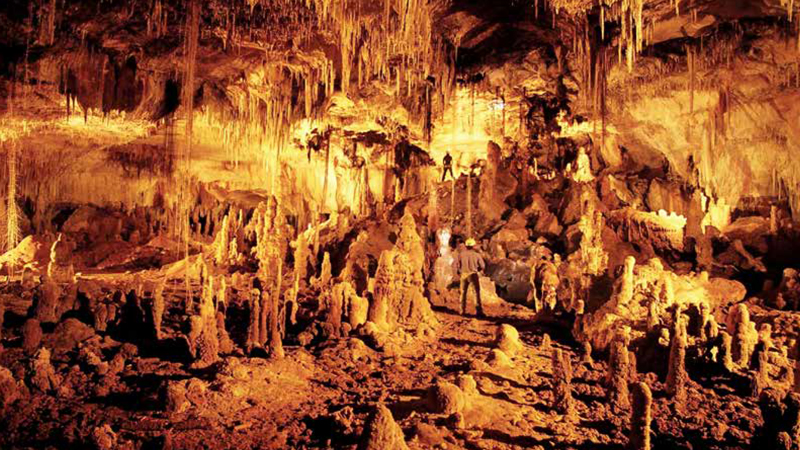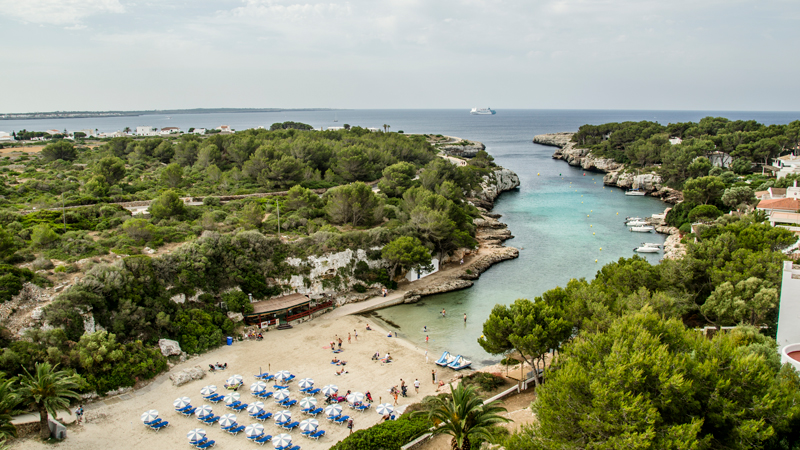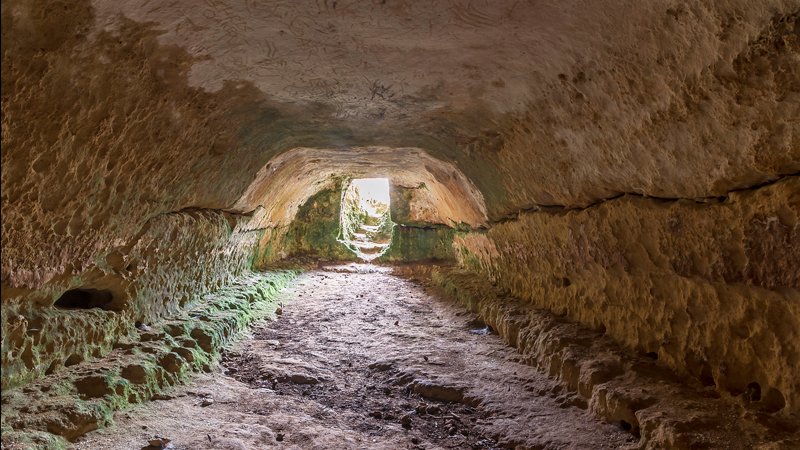Sa Cova de ses Tres Boques
A. ES CASTELLAR DE SA CALETA (O TORRE DE SANTANDRIA)
Torre de defensa costera construida en 1799, durante la última dominación británica de la isla (1798-1802). Las torres británicas de Menorca tenían como objetivo impedir el fondeo de las escuadras enemigas que pretendieran desembarcar,
asediar y rendir la isla. Debían alojar una pequeña guarnición militar y resistir el ataque de los cañones enemigos. El interés de esta torre radica en que es una de las más innovadoras de la ingeniería militar británica de la época en la isla, y un ejemplo de cómo las nuevas ideas de defensa se iban implementando ante la aparición de un armamento cada vez más potente. Es, junto con el resto de torres británicas costeras de la isla, el testimonio de que Menorca sirvió como campo de pruebas para el programa británico de defensa del siglo xix.
B.SA CALETA D’EN GORRIES
Caleta dominada por la torre de defensa construida en tiempos del general Charles Stuart, gobernador de Menorca entre 1798 y 1800. Es una pequeña cala precedida de una zona verde que dispone de todos los servicios. Su proximidad a la
ciudad, su fácil acceso y la tranquilidad y transparencia de sus aguas la han convertido, mucho antes del boom turístico iniciado en la década de 1960, en un lugar muy popular entre los ciudadelanos para nadar y refrescarse los calurosos días
de verano. A pesar de la presencia de algunas antiguas casitas de recreo frente el mar, la caleta no sufrió la presión urbanística hasta bien entrada la década de 1970. Desde entonces, a su alrededor se han ido configurando las urbanizaciones turísticas y residenciales de Son Blanc y Sa Caleta.
C.PATRIMONIO ARQUEOLÓGICO Y MILITAR EN LA CALA SANTANDRIA
Cala Santandria tiene una costa de poca altura y poca vegetación. Si miramos con atención, veremos algunas pequeñas cuevas excavadas en la roca. Son, curiosamente, hipogeos prehistóricos que los pobladores de la isla de hace más de dos mil años utilizaron como tumbas colectivas. Las cavidades en la roca que hay frente a la parada del autobús también forman parte de dicha necrópolis. Algunas de ellas fueron reconvertidas en trincheras o en nido de ametralladoras durante la Guerra Civil española. Cabe recordar que Menorca se mantuvo fiel a la República hasta la ocupación del bando nacional en febrero de 1939, y durante los años que duró la guerra la defensa de la costa fue una prioridad. El aprovechamiento de los recursos existentes, en este caso unas tumbas postalayóticas, ocultaba la presencia de dichas posiciones.
D.CALA SANTANDRIA
Como consecuencia de la guerra de los Siete Años entre Francia y Gran Bretaña, en 1756 una escuadra francesa coman dada por el Duque de Richelieu llegó a Santandria para conquistar Menorca, en aquel momento bajo dominio británico.
Desde aquí ocupó toda la isla y sitió el castillo de San Felipe de Maó, que se rindió poco después. La ocupación francesa de Menorca duró hasta 1763. No es extraño pues que con el retorno de la isla a la soberanía británica se construyera en
la bocana de esta resguardada cala una torre de defensa. Ha sido una de las calas más frecuentadas y queridas por los ciudadelanos. Y fue el lugar elegido para construir el primer hotel turístico de Ciutadella: Ses Voltes. La cala dispone en
verano de todos los servicios, está adaptada y se puede acceder a ella en transporte público todo el año.
A. ES CASTELLAR DE SA CALETA (OR TORRE DE SANTANDRIA)
A coastal defence tower built in 1799, during the last period of British control of the island (1798–1802). The British towers in Menorca had the purpose of stopping enemy forces that intended to come ashore, lay siege to the island and seize control of it from anchoring. They were intended to house a small military garrison and withstand attack by enemy cannons.
This tower is of particular interest because it is one of the most innovative examples of British military engineering from this period on the island, and it is an example of how new defensive ideas were implemented when faced with the appearance of ever more powerful armament. Along with the other British coastal towers on the island, it is evidence of how Menorca served as a testing ground for the British defensive programme of the nineteenth century.
B SA CALETA D’EN GORRIES
A small cove dominated by the defensive tower built in the time of General Charles Stuart, governor of Menorca between 1798 and 1800. This is a small cove with a green space before it, which has all facilities. Its proximity to the city, easy access and the tranquillity and transparency of its waters meant that long before the tourism boom that started in the 1960s it was a very popular place among the people of Ciutadella for bathing and cooling off on hot summer days. Despite the presence of some old holiday houses overlooking the sea, the cove was not affected by the pressure to develop until the 1970s. Since then, the tourist and residential developments of Son Blanc and Sa Caleta have grown around it.
C.ARCHAEOLOGICAL AND MILITARY HERITAGE IN CALA SANTANDRIA
Cala Santandria has a low-lying coast with little vegetation. If you look carefully, you will see some small caves dug out of the rock. These are prehistoric hypogaea that the inhabitants of the island used as collective tombs over two thousand years ago. The cavities in the rock opposite the bus stop are also part of this necropolis. Some of them were turned into trenches or machine gun nests during the Spanish Civil War. It is worth noting that Menorca remained loyal to the Republic until its occupation by Franco’s forces in February 1939, and defending the coast was a priority throughout the war. By using existing resources, in this case post-Talaiotic tombs, the presence of these positions was hidden.
D. CALA SANTANDRIA
As part of the Seven Years War between France and Great Britain, a French squadron commanded by the Duke of Richelieu came to Santandria in 1756 to conquer Menorca, which at that moment was under British control. From here it occupied
the whole island, laying siege to the castle of San Felipe in Maó, which surrendered shortly after. The French occupation of Menorca lasted until 1763. It is no surprise then that the with the return of British sovereignty to the island, a defensive tower was built at the mouth of this sheltered cove. It is one of the people of Ciutadella’s most frequented and best loved coves. It was also the spot chosen to build Ciutadella’s first hotel for tourists, Ses Voltes. In the summer, the cove has all facilities. It is accessible and you can get there by public transport all-year round.
